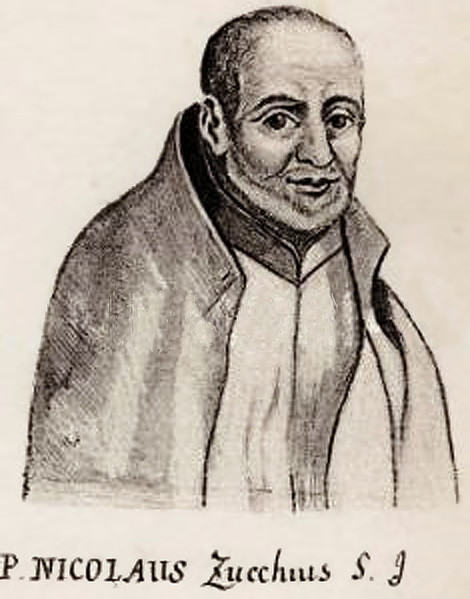<Back to Index>
- Astronomer Niccolò Zucchi, 1586
- Photographer Alfred Eisenstaedt, 1898
- King of England Henry VI, 1421
PAGE SPONSOR

Niccolò Zucchi (December 6, 1586 – May 21, 1670) was an Italian Jesuit, astronomer, and physicist.
As an astronomer he may have been the first to see the belts on the planet Jupiter (on May 17, 1630), and reported spots on Mars in 1640. He published his book "Optica philosophia experimentalis et ratione a fundamentis constituta" in 1652 – 56 in which he described his attempt in 1616 to construct a reflecting telescope, which may be the first time anyone ever tried to construct one. In his book he also demonstrated that phosphors generate rather than store light. He also published two other works on mechanics and machines.
Niccolò
Zucchi was fourth of eight children born into the noble family of
Pierre Zucchi and Francoise Giande Marie. Three of his sisters became
nuns, three of his brothers became Jesuits, and one brother became a
secular priest. Niccolò studied rhetoric in Piacenza and philosophy and theology in Parma. He finished his studies at the age of sixteen and entered the Jesuit order in Padua on October 28, 1602, in which he remained for the rest of his life. Zucchi taught mathematics, rhetorics and theology as a professor at the Collegio Romano, and then was appointed as rector of a new Jesuit college in Ravenna by Cardinal Alessandro Orsini.
He later served as the apostolic preacher, a post often referred to as
“preacher to the pope”, for about seven years. He received patronage
from Ranuccio II Farnese, Duke of Parma, to which Zucchi dedicated his
book Nova de machinis philosophia in 1642. He also dedicated his 1652 book Optica philosophia,
to Archduke Leopold of Austria. Near the end of his life, he was an
official of the Jesuit house in Rome. Zucchi died in Rome on May 21,
1670.
Niccolò
Zucchi published many books on science, including two works on the
philosophy of machines (analyses of mechanics) in 1646 and 1649, and Optica philosophica in 1652. He also wrote an unpublished Optica statica,
which has not survived. Some of the subjects Zucchi wrote about were
magnetism, barometers (denying the existence of the vacuum), and
demonstrated that phosphors generate
rather than store light. He also asserted that since Venus represented
beauty, it was closer to the Sun than Mercury (which represented skill). In 1632, Zucchi was a member of a Papal legate sent to the court of Ferdinand II. There he met Johannes Kepler, the German mathematician and astronomer. Kepler
encouraged Zucchi’s interest in astronomy. Zucchi maintained
correspondence with Kepler after returning to Rome. At one point when
Kepler was in financial difficulties, Zucchi, at the urging of the
Jesuit scientist Father Paul Guldin, gave a telescope of his own design to Kepler, who mentioned the gift in his book “The Dream”. Zucchi along with fellow Jesuit Daniello Bartoli may have been the first to see the belts on the planet Jupiter on May 17, 1630, and Zucchi reported spots on Mars in 1640. The crater Zucchius on the Moon is named in Niccolò Zucchi's honor.
One of the things cited by Zucchi in his 1652 book "Optica philosophia experimentalis et ratione a fundamentis constituta"
is his description of trying to make what may have been the first
reflecting telescope, in 1616. Zucchi described how he tried replacing
the lens of a refracting telescope with a borrowed bronze parabolic mirror. Zucchi tried looking into the mirror with a hand held concave lens but
did not get a satisfactory image, possibly due to the poor quality of
the mirror, the angle it was tilted at, or the fact that his head
partially obstructed the image. He apparently abandoned the idea and went back to using refracting telescopes.